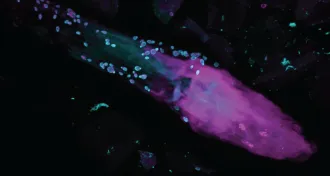Search Results for: Virus
Skip to resultsCan’t find what you’re looking for? Visit our FAQ page.
6,282 results for: Virus
-
 Health & Medicine
Health & MedicineBird flu infects three in China
The H7N9 influenza virus has sickened three people, killing two, in first known human infections.
-
 Psychology
PsychologyLight found in cocaine addiction tunnel
Using lasers, scientists target a sluggish set of neurons in rats to ease drug compulsion.
-

-
 Life
LifeNew bird flu claims more victims
H7N9 influenza spreads to Beijing, may come from poultry and pigeons.
-
 Health & Medicine
Health & MedicineCircumcision changes penis biology
Altered mix of microbes might reduce susceptibility to viral infections.
By Nathan Seppa -
 Life
LifeMutation makes H5N1 flu lose its grip
Laboratory-added genetic change makes avian influenza unable to bind to bird cells.
-
 Health & Medicine
Health & MedicineHIV vaccine trial stopped
Shots-plus-booster strategy deemed ineffective in preventing infection.
By Nathan Seppa -
 Life
LifeGenetic fossils betray hepatitis B’s ancient roots
Modern bird genomes reveal evidence that virus is at least 82 million years old.
-
 Health & Medicine
Health & MedicineBlack women may have highest multiple sclerosis rates
Large study counters common assumption that whites get MS more.
By Nathan Seppa -
 Life
LifeViruses and mucus team up to ward off bacteria
Phages may play an unforeseen role in immune protection, researchers find.
-
 Life
LifeFoot fungi a thriving, diverse community
A skin census finds that toes and heels have the most fungal types.
By Meghan Rosen -
 Life
LifeExperimental vaccine protects against many flu viruses
Ferrets that receive shot can fight off variety of influenza strains.